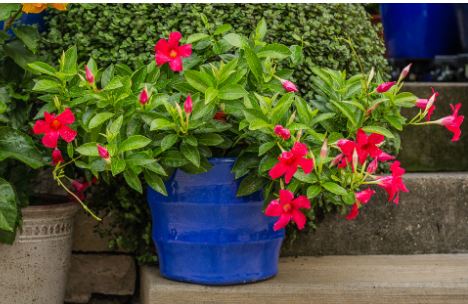
Mandevilla
Mandevilla and Bougainvillea are both beloved for their vibrant blooms and ability to transform any garden space with their lush, colorful presence, yet they differ in several notable ways, starting from their origins to their care requirements.
Both mandevilla (Mandevilla spp.), known as Chilean jasmine, and bougainvillea (Bougainvillea spectabilis) are tropical vines. They are grown as summer annuals in most areas of North America because they are perennials only in U.S. Department of Agriculture plant hardiness zones 10 and 11. While both vines climb by means of twining themselves around a support, they are otherwise unrelated.
Mandevilla, formerly called dipladenia, is a member of the dogbane (Apocynaceae) plant family. Members of this family, which include periwinkle (Vinca spp.) and oleander (Nerium oleander), usually exude a milky sap when cut. Bougainvillea, named for Admiral Louis de Bougainville, who discovered it in 1768, is a member of the four-o’-clock (Nyctaginaceae) family, whose members commonly bear small, tubular flowers.
Mandevilla grows to about 15 feet, climbing by twining itself around a trellis or arbor. Bougainvillea is a sharply spined woody vine that can reach 30 feet tall. It is usually trimmed annually to a shrubby form, with branches 2 to 4 feet long and can also be used as a groundcover. One low-growing groundcover variety is “Golden Jackpot” (Bougainvillea “MonSam”), a gold and green variegated plant with purple bracts that reaches only 15 inches tall but spreads 5 feet wide.
Both vines can be grown outdoors in warm weather or used as houseplants. Mandevilla prefers a site in part shade, in well-drained, humusy soil. It is a heavy feeder and should be fertilized every two weeks with a 10-20-10 or 20-20-20 formula. Indoors, it needs bright, indirect light and evenly moist soil. Bougainvillea thrives in full sun and may need supplemental lighting if grown indoors. Outdoors, it prefers sandy, lean soil. In soil that is too rich, it won’t bloom. Bougainvillea needs the same fertilizer regimen as mandevilla. Both vines are hardy only in USDA zones 10 and 11. Mandevilla is native to the tropical areas of the American South, while bougainvillea is native to Brazil.

Bougainvillea
Key Differences
Origin and Classification
Mandevilla
- Family: Apocynaceae
- Origin: Native to Central and South America.
- Botanical Background: Previously known under the genus Dipladenia, but now most are classified as Mandevilla.
Bougainvillea
- Family: Nyctaginaceae
- Origin: Native to South America, particularly Brazil.
- Botanical Background: Named after Louis Antoine de Bougainville, a French navigator.
Growth Habit
Mandevilla
- Growth Type: Mostly climbing vines but can be grown as a shrub with support.
- Growth Rate: Fast during the warm seasons.
- Size: Can grow up to 10-20 feet (3-6 meters) if left unchecked.
Bougainvillea
- Growth Type: Vigorous climbers or can be shaped into bushes or even bonsai.
- Growth Rate: Very fast, can cover large areas quickly.
- Size: Can reach up to 30 feet (9 meters) or more with proper support.
Leaves and Flowers
Mandevilla
- Leaves: Glossy, oval, and usually dark green.
- Flowers: Large, trumpet-shaped flowers. Common colors are pink, red, yellow, and white. They are known for their fragrance in some species.
Bougainvillea
- Leaves: More variable, often ovate to lanceolate, can be variegated.
- Flowers: The actual flowers are small, white, and tubular, but they are surrounded by three large, colorful bracts which are often mistaken for petals. Colors include purple, pink, red, orange, white, and yellow.
Environmental Needs
Mandevilla
- Sunlight: Prefers full sun to partial shade.
- Soil: Well-draining soil with some organic matter.
- Watering: Regular watering, but can tolerate some drought once established.
- Temperature: Not frost-tolerant, typically treated as an annual in colder climates or brought indoors.
Bougainvillea
- Sunlight: Thrives in full sun; needs at least 5 hours of direct sunlight for good blooming.
- Soil: Drought-tolerant once established, prefers sandy, well-drained soil.
- Watering: Less frequent watering encourages flowering. Overwatering can reduce bloom.
- Temperature: Also not frost-tolerant but can survive light frost if well-established.
Cultivation and Care
Mandevilla
- Pruning: Prune in late winter or early spring to control size and promote bushiness.
- Support: Needs trellises or other supports for climbing.
Bougainvillea
- Pruning: Prune to shape or control size; heavy pruning can be done after flowering.
- Support: Also requires support for climbing or can be used as ground cover.
Uses
Mandevilla
- Often used in garden borders, containers, or on trellises for vertical gardening.
Bougainvillea
- Popular for its vibrant display, used for covering walls, fences, or in hanging baskets. Also used in landscaping for its drought tolerance.
Pests and Diseases
Mandevilla
- Susceptible to spider mites, aphids, and whiteflies.
Bougainvillea
- Generally hardy but can be affected by aphids, caterpillars, and scale.